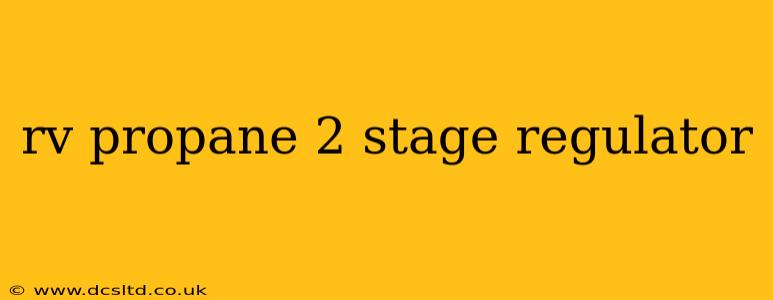Choosing the right propane regulator for your RV is crucial for safety and reliable appliance operation. A two-stage regulator offers superior performance and safety compared to single-stage models, making it a popular choice among RVers. This guide dives deep into the world of RV propane two-stage regulators, answering your burning questions and helping you make an informed decision.
What is a Two-Stage Propane Regulator?
A two-stage propane regulator is a pressure-reducing device that lowers the high pressure of propane from the tank (approximately 100-200 PSI) to a safe and usable pressure for your RV appliances (typically 11 inches of water column or 0.4 PSI). Unlike a single-stage regulator, which performs this reduction in one step, a two-stage regulator does it in two:
- Stage 1: The first stage reduces the high tank pressure to an intermediate pressure. This provides a stable supply of propane regardless of the tank's fill level.
- Stage 2: The second stage further reduces the intermediate pressure to the low pressure required by your appliances. This ensures consistent gas flow even under fluctuating demand.
Why Choose a Two-Stage Regulator for Your RV?
Two-stage regulators offer several significant advantages:
- Increased Safety: The staged reduction in pressure minimizes the risk of sudden pressure surges that could damage appliances or create a hazardous situation. The more stable pressure output is inherently safer.
- Consistent Appliance Performance: Fluctuations in tank pressure are common, especially as the tank empties. A two-stage regulator compensates for these fluctuations, ensuring consistent gas flow to your appliances, preventing inconsistent heating or cooking.
- Longer Lifespan: The reduced stress on the system due to smoother pressure regulation contributes to a longer lifespan for both the regulator and connected appliances.
- Improved Efficiency: By maintaining a consistent pressure, two-stage regulators optimize fuel usage, potentially leading to better fuel economy.
How Does a Two-Stage Regulator Differ from a Single-Stage Regulator?
The key difference lies in the pressure reduction process. A single-stage regulator reduces the high tank pressure directly to the low appliance pressure in one step. This can lead to pressure fluctuations, particularly as the tank empties, impacting appliance performance and potentially posing a safety risk. A two-stage regulator provides a more stable and controlled pressure reduction, resulting in a safer and more consistent experience.
What Size Two-Stage Regulator Do I Need for My RV?
The size of the regulator you need depends on the size and number of propane appliances you intend to use simultaneously. Check your RV's specifications or consult a qualified technician to determine the appropriate BTU (British Thermal Unit) rating. A larger capacity regulator is better for multiple appliances or larger appliances demanding higher BTU output.
How Often Should I Replace My RV Propane Two-Stage Regulator?
While propane regulators generally have a long lifespan, it's crucial to inspect them regularly for damage, leaks, or corrosion. Manufacturers typically recommend replacing your regulator every few years, even if it appears to be functioning correctly. Regular inspection and timely replacement are crucial safety measures.
Can I Install a Two-Stage Regulator Myself?
While some individuals may attempt DIY installation, working with propane requires caution and expertise. Improper installation can lead to gas leaks and serious safety hazards. It is highly recommended to have a qualified RV technician install or replace your propane regulator to ensure proper functionality and safety. Always refer to the manufacturer's instructions and follow local safety regulations.
What are the signs of a faulty two-stage propane regulator?
Signs of a malfunctioning regulator can include: weak or inconsistent appliance performance, a hissing sound coming from the regulator, the smell of propane, or visible damage to the regulator itself. If you observe any of these signs, immediately shut off the propane tank and contact a qualified technician for inspection and repair or replacement.
Are there different types of two-stage RV propane regulators?
While the basic function remains the same, two-stage regulators can vary slightly in design, features, and capacity. Some may incorporate additional safety features, such as a built-in pressure relief valve. Always choose a regulator that is specifically designed for RV use and meets relevant safety standards.
This comprehensive guide aims to offer a thorough understanding of RV propane two-stage regulators. Remember, safety should always be your top priority when dealing with propane. If you have any doubts or concerns, consult a qualified professional.
